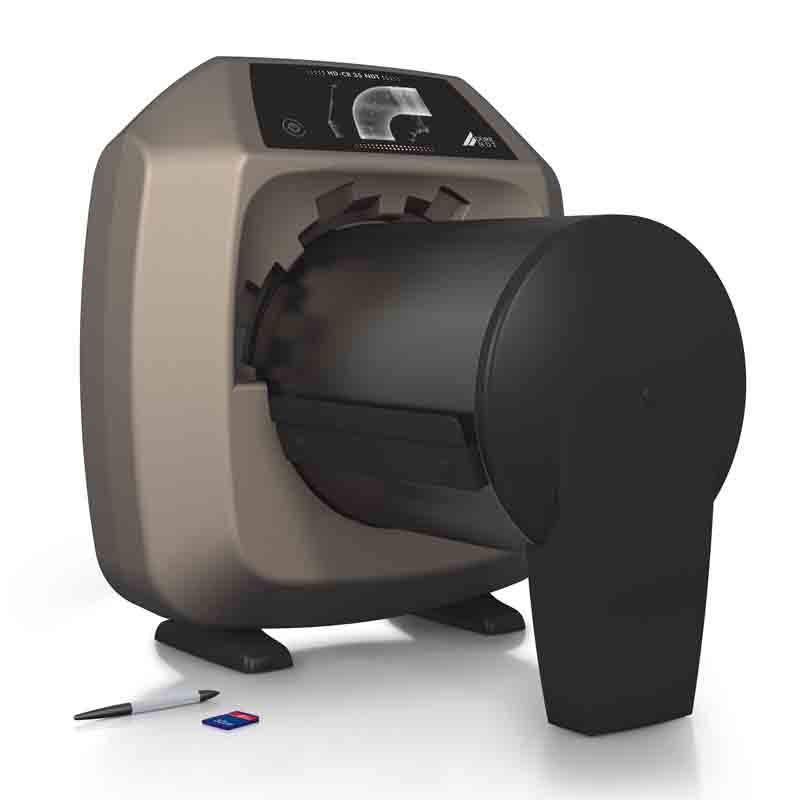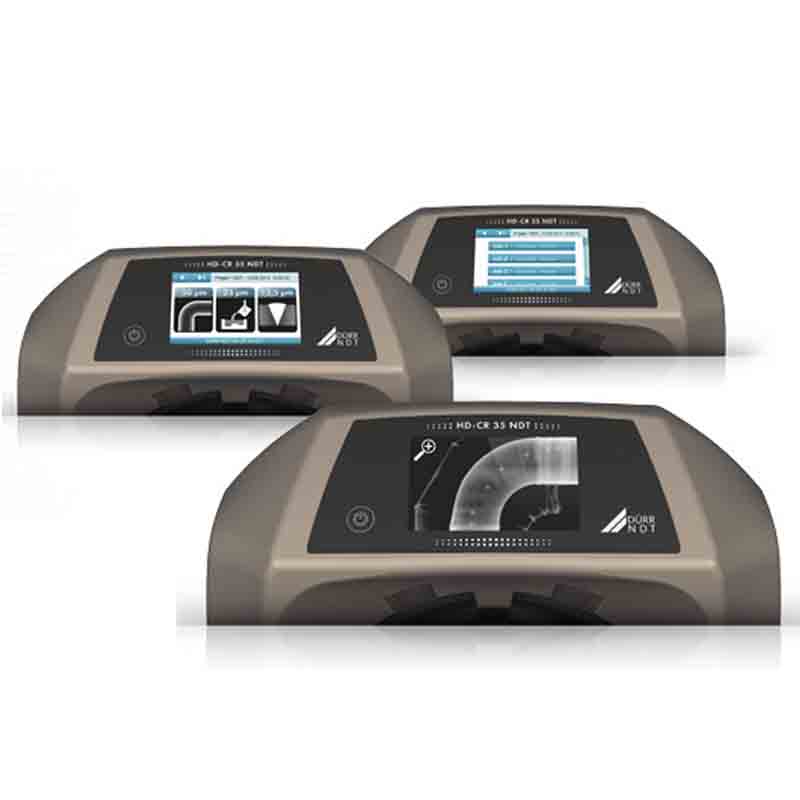HD - CR 35 NDT
Computed radiography or CR uses similar equipment to conventional radiography with the exception that in place of a traditional X-Ray film, an Imaging Plate (IP) made of photostimulable phosphor is used. The IP is housed in a cassette and placed under the part to be examined and an exposure is made with either X or Gamma radiation. Instead of taking an exposed film into a darkroom for developing in chemical tanks or an automatic film processor, the IP is run through a special laser scanner, or CR scanner, that reads and digitizes the image. The digital image can then be viewed and enhanced using software that has functions very similar to other conventional digital image-processing software, such as contrast, brightness, filtration and zoom.
The basic physics of the process are that the IP containing photostimulable phosphors. When exposed to radiation, the phosphors store the radiation received in local electron energies. When the IP is processed through the CR scanner, the scanning laser beam causes the electrons to drop to lower energy levels, emitting light that is detected by a photomultiplier tube (PMT), which is then converted to an electrical signal, which is in turn converted to a digital image.
The CR scanner automatically erases the IP after the laser scanning is complete, meaning that the IP can be re-used. Whilst theoretically IP’s can be re-used thousands of times, if they are handled carefully, IP handling under real life conditions often means they require replacing after several hundred uses.
Typical examples of CR in NDT are:
- Casting Inspection.
- Weld Inspection.
- Inspection of Aerospace components such as Turbine Blades.
- Corrosion under Insulation (CUI).
- Wall Thickness Measurements.
What should I consider in deciding to use CR?
CR is understood to be the replacement for traditional X-Ray film. With X-Ray film radiography, the only variable is the film type. With CR we have different IP’s and the ability to adjust up to four parameters within the CR scanner to optimise the image quality to suit the required inspection task. Euroteck personnel are available to discuss your application and advise on the most suitable CR system for your purpose.
Dürr NDT HD CR Scanners
Dürr NDT is the first company worldwide that has developed a 12.5 micron laser spot scanner that, combined with high resolution phosphor storage IP’s, has met all of the stringent requirements of EN 14784, EN 17636 and ASTM E2446. The HD CR 35 NDT and exceed the requirements of Rolls Royce RRP 58009 for both castings and welds.
Combining high definition IP’s and the HD-CR devices achieves the unique Basic Spatial Resolution of 30µm overall system classification for the first time. This performance has been independently certified by BAM in Germany.
The HD CR 35 NDT scanner has the unique ‘TreFoc’ technology. This always sets the laser beam in relation to the IP, and the object to be examined, so that the maximum resolution is achieved, whilst simultaneously attaining the optimal signal-to-noise ratio.
The HD-CR 35 NDT scanner can be battery operated. We can supply a complete battery operated solution including X-Ray source from 120kV to 320kV, CR scanner and PC/Monitor for unparalleled on site performance.
- Resolution: 12.5 – 200 µm continuously adjustable (TreFoc Technology)
- BSR (Basic Spatial Res.): 40 µm certified by BAM
- Grey level resolution: 16 bit, 65.536 grey levels
- Dimensions (H x W x D): 40 x 37 x 47 cm
- Weight: 17,5 kg
- Electrical: 100 – 240 VAC / 50 – 60 Hz, < 140 W
- Temperature range: 10 to 35 °C
- Noise Level: < 39 dB(A)
- Laser Class: I (EN 60825-1: 1994-03 + A1: 2002-07 + A2: 2001-03) + CFR 1040.10
- PC-Connection: Ethernet (TCP-IP protocol), W-LAN
- Display: 4.3“ TFT, 800 x 480 px.
- Storage: SDHC, max 32 GB.
- Software: DÜRR NDT D-Tect.


